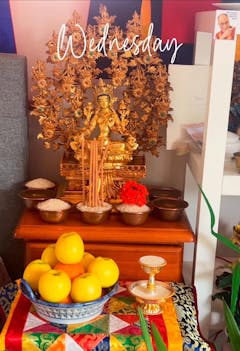Beautifully Hand-carved Hayagriva Statue
Fierce Hayagriva Statue | Tibetan Buddhist Wrathful Protector
Handcrafted Hayagriva Statue | Wrathful Deity for Protection & Wisdom
Hayagriva Statue | 24K Gold Gilded Tibetan Art
Hayagriva Statue: Embrace Spiritual Power
Hayagriva Statue: The Powerful Deity of Protection
Hayagriva with Consort: The Dynamic Force of Enlightened Energy
Lord Hayagriva Statue | Dharma Protector
Oxidized Hayagriva Statue: Invoke Protection and Fierce Compassion
Tibetan Hayagriva Statue | Wrathful Manifestation of Avalokiteshvara
Traditional Hayagriva Statue For Devotees and Collectors
Hayagriva Statue: The Fierce Protector of Dharma
Hayagriva statue is a majestic portrayal of the wrathful manifestation of Avalokiteshvara, the Bodhisattva of Compassion. With his fiery expression, horse-head crown, and dynamic pose, Hayagriva embodies the fierce compassion needed to overcome obstacles and protect the Dharma.
Expertly handcrafted in Nepal, this statue is made of copper with gold gilding and adorned with semi-precious stones. Every detail reflects the deity’s dynamic energy: his three glaring eyes radiating wisdom, his six arms wielding sacred implements, and his blazing flames symbolizing the purification of ignorance and negativity. The intricate craftsmanship pays homage to the rich Himalayan artistic tradition, making this statue a masterpiece of both spiritual and aesthetic significance.
Beyond its artistic value, the Hayagriva statue serves as a beacon of courage and transformation, inspiring practitioners to channel their inner strength to overcome challenges and cultivate wisdom and compassion.
Hayagriva: The Wrathful Protector and Purifier
Hayagriva, known as “Horse-Necked” due to the horse-head crowning his own, is a wrathful manifestation of Avalokiteshvara. Despite his fierce appearance, he embodies the compassion of the Bodhisattva, wielding wrath to swiftly eliminate obstacles and protect sentient beings from harm.
In Vajrayana Buddhism, Hayagriva is invoked as a protector of the Dharma, a remover of obstacles, and a healer of diseases, particularly those caused by negative energies or malevolent forces. His practice empowers practitioners to confront their inner and outer demons with unwavering resolve, transforming fear and ignorance into wisdom and compassion.
Symbolism and Attributes of the Statue
The Hayagriva statue is rich in symbolic elements, each reflecting his enlightened qualities:
- Three Faces: His three faces symbolize the wisdom of the past, present, and future. The central face is wrathful red, embodying compassion; the right face is white, symbolizing purity; and the left face is green, representing activity.
- Six Arms: Hayagriva’s six arms wield various implements, including a vajra, sword, and trident, symbolizing the tools needed to cut through ignorance and protect sentient beings.
- Horse Head: The horse-head crowning his own emits a piercing neigh, symbolizing the sound of the Dharma that awakens beings from ignorance.
- Blazing Flames: The flames surrounding his form represent the purification of negative karma and the destruction of delusion.
-
Dynamic Posture: Standing in alidha (warrior stance), Hayagriva exudes energy and readiness to confront obstacles.
- Ornaments and Garments: His adornments of bone ornaments and wrathful attire symbolize his mastery over samsaric existence and his fearless approach to aiding sentient beings.
The Practice of Hayagriva
Hayagriva’s practice is a powerful tool for removing obstacles, healing ailments, and cultivating inner strength. Practitioners meditate on his wrathful yet compassionate form, visualizing the purifying flames and the sound of his neigh as they dissolve ignorance and negativity.
The mantra of Hayagriva is:
Hrih Benza Hayagriva Hung Phat
This mantra invokes his fierce energy and compassion, empowering practitioners to overcome difficulties and protect the Dharma.
A Guardian for Your Altar
The Hayagriva statue is more than an artistic masterpiece; it is a spiritual ally for those seeking protection, healing, and transformation. Whether placed on an altar or used as a focus for meditation, this statue serves as a reminder of the boundless compassion and fierce wisdom required to overcome life’s challenges and benefit all beings.
For practitioners, collectors, or admirers of sacred art, this statue is a profound symbol of the power of compassion to conquer all obstacles and illuminate the path to enlightenment.






































































